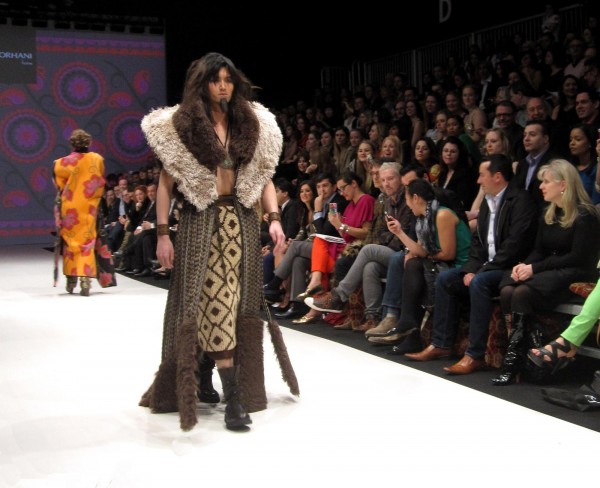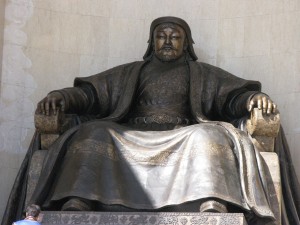
Carpets fit for the Runway
When Korhani Home rolled out the carpet at Toronto’s Fashion Week, they had no intention for it to be walked on. Instead they found ingenious ways to evoke style eras through history, reflecting the seasonal designs they are offering. Who would have thought that you could make carpets into capes for masquerade balls or evoke Genghis Khan?
Their new collection of home carpets were wrapped around models in ways that would make my fingers bleed just imagining the labour of coaxing an inherently inflexible material into shapes that follow the form of the body.

From Genghis Khan to Kublai Khan

Something about the runway show inspired me to delve into the history of the Mongol invasion. As a nomadic people, living a harsh existence on the northern plains, the Mongols had herded yaks and traded fur and hides for grains and tea for centuries. With this tea they prepared a fortifying beverage call Suutei Tsai. It is still a staple. It is made by boiling pu erh style cake tea or brick tea with yak butter, grain, milk and salt.
Genghis Khan, correctly pronounced Chinggis Khan, had a vision to unite his country. He brought 4 warring Mongol tribes together and with this united strength took on and defeated armies many times their size. He struck China during its esthetic Song Dynasty (960 – 1279) which valued scholarly pursuits such as poetry, calligraphy and the masterly preparation and appreciation of tea. Pre-occupied as they were with artistic passions, the Song’s warrior skills were not as valued or practiced as in earlier dynasties. China’s army had weakened in certain regions. Khan’s newly united Mongol tribes were now strong in numbers and as skilled archers and horsemen, were able to invade huge geographical regions of Asia. The invasions were bloody, destructive and took six decades to complete. By the time Kublai Khan (Genghis Khan’s grandson) was in place as Emperor, the Mongolian Yuan Dynasty (1271–1368) conquered and subsequently ruled a vast swath of land from China to Persia and Eastern Europe.

Support for Craftsmen and the Merchant Class
The Mongols were largely successful in their imperialism because they kept local government and bureaucracies in place in each conquered territory. Many highly talented esthetes who were employed in the Song government lost their positions however, and they sought work that would allow them to use their artistic skills. The Yuan revered artisans and craftsmen, so these former bureaucrats were able to find work painting and developing new techniques for blue and white porcelain and introducing new coloured under-glazings. Many crafts including weaving and porcelain production flourished during the Yuan Dynasty.

The Yuan also supported and encouraged the merchant class. During the Yuan Dynasty, the Silk Road was repaired and maintained in order to keep China connected to the Middle East and Russia. Trade was important to the Mongols and Kublai Khan sent envoys as far as Rome to encourage trade with Medieval Europe. The tea trade continued along the Silk Road. Marco Polo met many times with the Kublai Khan in Dadu the capital city, (now Beijing) and I venture to guess that he partook of a taste of tea. He described Kublai Khan as a benevolent leader who lowered taxes in troubled times and provided for the destitute. He was indeed the most productive ruler of the Dynasty. The peasant farmers didn’t fare so well though. Much of their land was confiscated early after the conquest and was used as grazing land for the Mongols wandering livestock. Farmers continued to revolt until the Yuan lost their hold on power.

Back to the Steppes
As the Yuan economy failed and the empire splintered, the Mongols split up into their four kingdoms. They slowly faded back to the north. During most of the twentieth century, Mongolia was under the governance of the Soviet Union. They are now a sovereign country with most of their 2.75 million people dwelling in Gers (Yurts) and hunting the plains as they did 800 years ago. It seems strange that such a powerful nation could shrink back to its original steppes.The Yuan rule was a fascinating time in the evolution of Chinese culture. Some would say an interruption, but there is no doubting the influence the Yuan Dynasty had on the “outside” world. Along the Silk Road, fashion, pottery and folktales were shared. Tea made its way as far as Turkey where it thrived. Had the Yuan persisted, I believe that Europe would not have had to wait another 400 years before enjoying the refreshing beverage that has now found it’s way into every household worldwide. Speaking of tea, I’m definitely going to try making Suutei Tsai sometime. Have you tried it? Do you have any tips on how to make it or how to “enjoy” it? Is it delicious or an “acquired” (horrible) taste?


